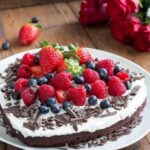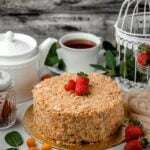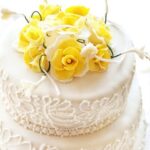Are you a beginner looking to learn how to decorate a cake for beginners at home? Decorating a cake can be a fun and creative way to add a personal touch to any celebration. Whether you’re baking for a special occasion or just want to explore a new hobby, learning the basics of cake decorating can be both enjoyable and rewarding.
In this article, we’ll take you through the essential tools and equipment needed for decorating a cake, basic techniques for beginners, tips on choosing the right frosting and icing, step-by-step instructions on how to crumb coat a cake, simple decoration ideas, and tricks for perfecting your skills. We’ll help you embrace the art of cake decorating in your own kitchen and add personalization and flair to your creations.
With the right guidance and practice, you can easily become a pro at creating beautiful, professionally decorated cakes at home. So, if you’ve ever wanted to unleash your creativity in the kitchen or impress your loved ones with stunning desserts, keep reading as we guide you through the art of cake decorating.
Essential Tools and Equipment for Decorating a Cake
Decorating a cake at home can be a fun and rewarding experience, especially for beginners. To get started, it’s important to have the right tools and equipment on hand. Here are some essential items you’ll need to decorate a cake like a pro:
- Offset Spatula: This tool is essential for spreading frosting and smoothing it out on the cake surface.
- Piping Bags and Tips: These allow for detailed designs and decorations on the cake, such as borders, flowers, and writing.
- Cake Turntable: A turntable makes it easier to frost and decorate the cake evenly from all sides.
- Bench Scraper: This tool helps create clean and smooth edges on the cake.
- Decorating Comb: Ideal for creating textured designs on the sides of the cake.
In addition to these tools, it’s important to have the right equipment for preparing your cake before decorating. Basic baking supplies such as mixing bowls, measuring cups and spoons, a whisk or electric mixer, and cake pans are essential for baking your cakes. With these tools and equipment in hand, you’ll be well-prepared to begin your cake decorating journey.
Finally, having a good quality rotating cake stand can make it easier to decorate your creation from every angle. This is an optional but useful piece of equipment that can make the process smoother for beginners.
Now that you know what tools and equipment are needed for decorating a cake at home, let’s move on to learning some basic techniques that will help you get started with your decorating adventure.
Basic Cake Decorating Techniques for Beginners
Decorating a cake can seem like a daunting task, especially for those who are new to the world of baking and confectionery. However, with the right techniques and some practice, anyone can create beautiful and delicious works of art right in their own kitchen. Here are some basic cake decorating techniques for beginners that will help you get started on your journey towards becoming a pro pastry chef.
One of the most fundamental cake decorating techniques is piping. Piping involves using a pastry bag to apply frosting or icing to a cake in various designs and patterns. This technique allows you to create intricate borders, floral designs, lettering, and other decorative elements on your cake.
To get started with piping, you’ll need to invest in a few basic piping tips and a reusable pastry bag. Practice on a flat surface before attempting to pipe directly onto your cake.
Another important cake decorating technique for beginners is using fondant. Fondant is a versatile type of icing that can be rolled out into sheets and draped over cakes for a smooth, polished look. It can also be shaped and molded into 3D decorations such as flowers, figures, and other objects. While working with fondant may take some practice to perfect, it adds an elegant touch to any cake design.
Lastly, mastering the art of simple buttercream designs is essential for any beginner cake decorator. Buttercream is one of the most popular types of frosting used for decorating cakes due to its creamy texture and ability to hold various shapes when piped. Learning how to create rosettes, swirls, dots, and other basic buttercream designs will allow you to add visual interest and texture to your homemade cakes.
| Technique | Description |
|---|---|
| Piping | Using a pastry bag to apply frosting or icing in various designs |
| Fondant | Versatile icing that can be rolled out into sheets or shaped into 3D decorations |
| Buttercream Designs | Creating rosettes, swirls, dots using buttercream frosting |
Choosing the Right Frosting and Icing for Your Cake
When it comes to cake decorating, one of the most important decisions you will make is choosing the right frosting and icing for your cake. The type of frosting or icing you use can greatly impact the final look and taste of your cake, so it’s essential to choose wisely. There are several different options to consider, each with its own unique properties and uses.
One popular choice for cake frosting is buttercream, which is known for its smooth texture and creamy flavor. Buttercream is highly versatile and can be used for everything from simple frosting to intricate piping designs. Another option is fondant, a pliable sugar paste that can be rolled out to cover cakes with a smooth, flawless finish. Fondant is often used for more formal or elegant designs due to its clean, polished look.
For those who prefer a lighter, fluffier frosting, whipped cream or cream cheese icing may be the perfect choice. These frostings are especially well-suited for filling and topping cakes with fresh fruit or berries. Additionally, ganache, a rich mixture of chocolate and cream, is ideal for creating a decadent, glossy finish on cakes.
In addition to considering the flavor and texture of your frosting or icing, it’s important to take into account the temperature and storage conditions of your cake. Some frostings hold up better in warm environments while others are more sensitive to heat or humidity. By carefully selecting the right frosting or icing for your cake based on these factors, you can ensure that your creation not only looks beautiful but also tastes delicious.
| Types | Characteristics |
|---|---|
| Buttercream | Smooth texture and creamy flavor |
| Fondant | Pliable sugar paste for smooth finish |
| Whipped Cream/Cream Cheese Icing | Lighter and fluffier option for fruits/berry cakes |
| Ganache | Rich mixture of chocolate and cream creating a glossy finish. |
Step-by-Step Instructions on How to Crumb Coat a Cake
Prepare Your Cake
Before you start crumb coating your cake, make sure it is completely cooled and level. You can use a serrated knife to trim the top of the cake if necessary. It is also important to ensure that any loose crumbs are removed from the surface of the cake before applying the crumb coat.
Making the Crumb Coat
To make the crumb coat, you will need to apply a thin layer of frosting or icing to the entire cake. This initial layer will help to seal in any crumbs, creating a smooth base for the final layer of frosting. Use an offset spatula to spread the frosting evenly across the top and sides of the cake, ensuring that it is completely covered.
Chilling the Cake
Once you have applied the crumb coat, place your cake in the refrigerator for at least 30 minutes to allow the frosting to firm up. This will make it easier to apply the final layer of frosting without disturbing the crumb coat. Chilling also helps to set the crumbs in place, preventing them from mixing with your final layer of frosting.
By following these step-by-step instructions, you can successfully crumb coat a cake and create a perfect base for your decorative frosting or icing. Remember that practice makes perfect, so don’t be disheartened if your first attempt isn’t flawless. With time and patience, you’ll be able to master this essential technique for achieving professional-looking cakes right in your own kitchen.
Simple Cake Decoration Ideas for Beginners
Decorating a cake as a beginner can be both exciting and daunting at the same time. But with the right guidance and some simple ideas, you can create a beautifully decorated cake that will impress your family and friends. Here are some easy cake decoration ideas for beginners to try at home:
- Use fresh fruit: A simple yet effective way to decorate a cake is by adding fresh fruit on top. Sliced strawberries, blueberries, raspberries, or kiwi can add a pop of color and freshness to your cake.
- Patterned piping: Invest in some piping bags and tips to create fun patterns on your cake using different colored frosting. You can start with basic patterns like dots, swirls, or stars to add visual interest to your cake.
- Edible flowers: Edible flowers are an elegant way to decorate a cake. You can use whole edible flowers or separate the petals and sprinkle them over the frosting for a delicate touch.
These simple decoration ideas are perfect for beginners who are just starting their cake decorating journey. They require minimal skill and can instantly elevate the look of your homemade cakes.
Remember, practice makes perfect, so don’t be discouraged if your first few attempts don’t turn out exactly as planned. With time and patience, you’ll develop your own unique decorating style and create stunning cakes that reflect your creativity and passion for baking.
Tips and Tricks for Perfecting Your Cake Decorating Skills
Once you have mastered the basic techniques of cake decorating, it’s time to take your skills to the next level with some tips and tricks that will help you perfect your designs.
Practice Makes Perfect
One of the most important tips for improving your cake decorating skills is to practice regularly. The more you work with different frosting and icing consistencies, piping techniques, and decorations, the more confident and skilled you will become. Set aside time each week to try out new designs or techniques, and don’t be afraid to experiment and make mistakes – that’s how you’ll learn and grow as a decorator.
Invest in Quality Tools
Having the right tools can make a world of difference in your cake decorating endeavors. Invest in high-quality piping bags, tips, turntables, offset spatulas, and other essential equipment. These tools will not only make the process easier but will also allow you to create more professional-looking designs.
Learn From Others
Take advantage of online tutorials, classes, and workshops to learn from experienced decorators. Whether it’s through YouTube videos or in-person courses, watching others demonstrate techniques and share their tips can provide valuable insights that will help you improve your own skills. Additionally, joining online communities or forums dedicated to cake decorating can offer a supportive network of fellow enthusiasts who can offer advice and feedback on your work.
Final Touches
Once you have crumb coated your cake and applied a base layer of frosting, it’s time to add the final touches that will truly make your cake design stand out. One way to add personalization and flair to your cake is by incorporating decorative elements such as edible flowers, chocolate shavings, or fresh fruit. These simple additions can take your cake from ordinary to extraordinary and are sure to impress your friends and family.
Another way to personalize your cake design is by using piping techniques to write a personalized message on the cake. Whether it’s a birthday greeting, anniversary wishes, or simply the recipient’s name, adding a thoughtful message with piped frosting can elevate the overall look of your cake and make it more meaningful to the person receiving it.
In addition to edible decorations and personalized messages, consider adding texture and dimension to your cake design. This can be accomplished through the use of different piping tips to create intricate designs or patterns on the surface of the cake. You can also experiment with adding layers or tiers to your cake for a more dynamic appearance. By paying attention to these final details, you can create a stunning masterpiece that not only tastes delicious but also looks visually appealing.
Conclusion
In conclusion, learning how to decorate a cake at home can be a fun and rewarding experience for beginners. With the right tools, basic techniques, and a little creativity, you can create beautiful and delicious works of art right in your own kitchen.
By acquiring the essential tools and equipment for cake decorating, understanding basic techniques, and choosing the right frosting and icing for your cake, you can start your journey into the world of cake decoration with confidence. Remember to take your time and practice patience as you perfect the crumb coating of your cake and explore simple decoration ideas.
As you continue to improve your cake decorating skills, don’t be afraid to add personal touches and flair to your designs. Whether it’s through intricate piping or creative use of colors and toppings, let your personality shine through in each creation.
Embracing the art of cake decorating at home is not only a wonderful way to express yourself but also a delightful way to bring joy to others through the gift of a beautifully decorated homemade cake. So, don’t be afraid to experiment and have fun with it.
Frequently Asked Questions
What Does a Beginner Need for Cake Decorating?
A beginner in cake decorating will need a few basic tools and supplies to get started. This would include an offset spatula for smoothing frosting, piping tips and bags for creating various designs, a turntable to make icing easier, and a good quality icing smoother.
Additionally, having the right ingredients such as fondant, food coloring, and edible decorations will also be essential in creating visually appealing cakes.
How to Decorate Cake in Home Simple?
Decorating a cake at home can be made simple by following a few key steps. First, ensure that the cake has completely cooled before attempting to decorate it. Then, use a thin layer of frosting called a crumb coat to seal in any loose crumbs before adding the final layer of frosting.
Using tools like spatulas or piping bags can help create different textures and designs on the cake’s surface. Finally, adding finishing touches such as fresh fruit, edible flowers, or sprinkles can enhance the overall look of the cake.
How Do You Decorate a Cake With Frosting for Beginners?
For beginners looking to decorate a cake with frosting, it’s important to start with the right consistency of frosting – not too thin or too thick. A simple way to do this is by adding small amounts of milk or powdered sugar until reaching the desired texture. Using an offset spatula or straight edge tool can help smooth out the frosting on the cake’s surface evenly.
Additionally, using different piping tips and techniques can add more intricate designs like rosettes or borders for an added decorative touch. With practice and patience, even beginners can achieve beautifully frosted cakes.

Welcome to my blog about home and family. This blog is a place where I will share my thoughts, ideas, and experiences related to these important topics. I am a stay-at-home mom with two young children. I hope you enjoy reading it! and may find some helpful tips and ideas that will make your home and family life even better!





